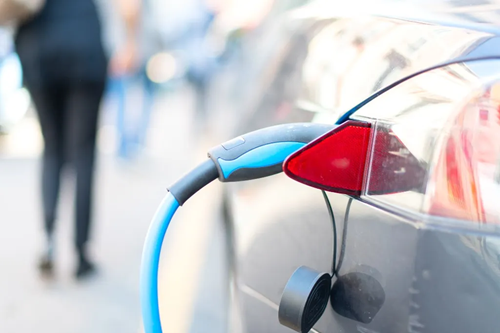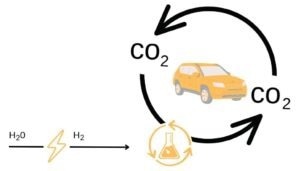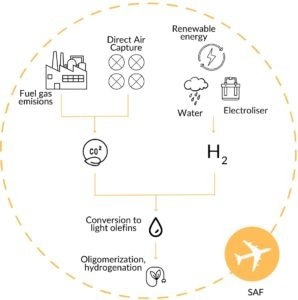When it comes to decarbonizing the planet, specific challenges connected to sustainable energy transition require resolution. Innovative initiatives have made it possible to build homes and roads with cement or pitch, which can trap CO2 and remove it from the atmosphere, reducing the carbon footprint. There are also innovative mattresses made from synthetic polyurethane foam manufactured with recycled CO2 and foods supplied in a completely sustainable and self-sufficient way that were grown using CO2-based fertilizers.

Image Credit: AIMPLAS
The Role of CO2 in the Future Sustainable Transport
In the transport sector, a sustainable future is already underway. We can draw inspiration from plants and microorganisms that convert CO2 into energy, applying this concept to create biofuels that meet our growing demand for sustainable energy in transportation.
Advancements in current technologies will enable aircraft to be powered by kerosene synthesized from CO2 and trucks to run on synthetic fuels derived from CO2 by around 2030. This shift will significantly reduce our reliance on fossil fuels, promoting carbon-neutral mobility and aiding in the fight against climate change.

Image Credit: AIMPLAS
E-fuels for Carbon Neutral Mobility
Synthetic and sustainable fuels, which help mitigate CO2, must be the focus of the transport sector's decarbonization.
Sustainable fuel requirements include reducing carbon emissions throughout its lifecycle. However, other factors are also crucial, including fresh water and preventing deforestation in the chemical processes.
Synthetic fuels, biofuels, and e-fuels are liquids similar to typical hydrocarbons like gasoline or diesel but are not made from fossil sources. These sustainable liquids result from the reaction between renewable hydrogen and industrial-captured CO2.
The captured CO2 is offset by the CO2 generated from the use of the e-fuel. Using CO2 provides new opportunities for economic growth through innovation, paving the way for the transition to a circular economy and decarbonization with reduced dependency on fossil fuels.

Image Credit: AIMPLAS
What is Considered a Green Fuel?
To be classified as a “green fuel”, the energy must be renewable, such as the electricity used to separate hydrogen and oxygen through electrolysis.
Sustainable aviation fuels (SAF) have become a viable alternative. Currently, SAF are used for commercial flights and have demonstrated a reduction in CO2 emissions of up to 80%. 1,2
SAF's chemical and physical characteristics are nearly identical to conventional aviation fuels. SAF can successfully be mixed with conventional fuels in a variety of proportions. The existing infrastructure can be used, and new motors are not required. SAF can be considered a drop-in fuel as it can be easily incorporated into existing fuel supplies.
E-fuels also need to meet three essential requirements:
- Continuous resources that avoid depletion while being economically, socially, and environmentally sustainable.
- Produced using raw materials other than petrol, carbon, or natural gas.
- Have the technical requirements and certification for use on commercial aircraft.
Technologies for Producing Drop-In Biofuels
Generally, the developed technologies for producing drop-in biofuels can be divided into four main categories:
- Oleochemical
- Thermochemical
- Biochemical
- Hybrid processes
Challenges and Opportunities of Low-Carbon Fuels
Many companies are either in production or attempting to commercialize bio-jet fuel in a variety of phases of technological preparation.3,4,5 It is important to note that emissions are a decisive factor in evaluating this technology, as they are the true indicator of the value of biofuel and the cost of reducing carbon emissions.
The challenges associated with commercializing a low-carbon fuel may change depending on the technology used, as some processes demand a large capital investment (gasification-Fischer Tropsch), and others demand high-cost raw materials.
Beyond obtaining biofuels from hydrotreated vegetable oils (HVO) or hydroprocessed esters and fatty acids (HEFA), the commercialization of other methods is still in progress. Even though the technological challenges are significant, sustainability and cost are the determining factors for successful technology.
In summary, using CO2 as a key material or co-reactant offers both a challenge and an opportunity, as it inspires the search for new solutions in the chemical industry for decarbonization and reducing the dependency on fossil fuels in transport.
AIMPLAS can assist companies with decarbonating, obtaining more sustainable fuels, and designing catalysts that will help overcome these challenges.

This information has been sourced, reviewed and adapted from materials provided by AIMPLAS.
For more information on this source, please visit AIMPLAS.